Related Research Articles

A bicycle, also called a bike or cycle, is a human-powered or motor-powered, pedal-driven, single-track vehicle, having two wheels attached to a frame, one behind the other. A bicycle rider is called a cyclist, or bicyclist.

The tandem bicycle or twin is a form of bicycle designed to be ridden by more than one person. The term tandem refers to the seating arrangement, not the number of riders. Patents related to tandem bicycles date from the mid 1880's. Tandems can reach higher speeds than the same riders on single bicycles, and tandem bicycle racing exists. As with bicycles for single riders, there are many variations that have been developed over the years.

A recumbent bicycle is a bicycle that places the rider in a laid-back reclining position. Most recumbent riders choose this type of design for ergonomic reasons: the rider's weight is distributed comfortably over a larger area, supported by back and buttocks. On a traditional upright bicycle, the body weight rests entirely on a small portion of the sitting bones, the feet, and the hands.
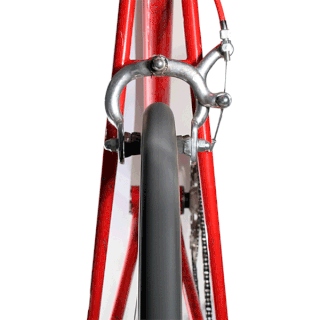
A bicycle brake reduces the speed of a bicycle or prevents it from moving. The three main types are: rim brakes, disc brakes, and drum brakes. There have been various types of brakes used throughout history, and several are still in use today.

The penny-farthing, also known as a high wheel, high wheeler and ordinary, was the first machine to be called a "bicycle". It was popular in the 1870s and 1880s, with its large front wheel providing high speeds and comfort. It became obsolete from the late 1880s with the development of modern bicycles, which provided similar speed amplification via chain-driven gear trains and comfort through pneumatic tyres, and were marketed in comparison to penny-farthings as "safety bicycles" because of the reduced danger of falling and the reduced height to fall from.
Shimano, Inc. is a Japanese multinational manufacturer of cycling components, fishing tackle and rowing equipment. It produced golf supplies until 2005 and snowboarding gear until 2008. Headquartered in Sakai, Japan, the company has 32 consolidated subsidiaries and 11 unconsolidated subsidiaries. Shimano's primary manufacturing plants are in Kunshan, China; Malaysia; and Singapore.
Campagnolo is an Italian manufacturer of bicycle components with headquarters in Vicenza, Italy. The components are organised as groupsets (gruppi), and are a near-complete collection of a bicycle's mechanical parts. Campagnolo's flagship components are the Super Record, Record, and Chorus groupsets with all three representing their recent shift to 12-speed drivetrains. Super Record and Record are the top groupsets, followed by Chorus, Potenza, Centaur and Veloce. Campagnolo also produces aluminum and carbon wheels, as well as other components.
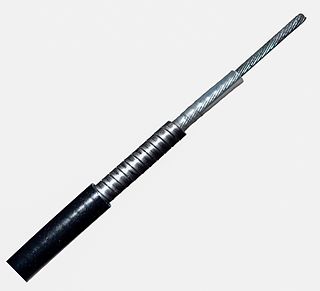
A Bowden cable is a type of flexible cable used to transmit mechanical force or energy by the movement of an inner cable relative to a hollow outer cable housing. The housing is generally of composite construction, consisting of an inner lining, a longitudinally incompressible layer such as a helical winding or a sheaf of steel wire, and a protective outer covering.
A groupset or gruppo is a bicycle component manufacturer's organized collection of mechanical parts. It generally refers to all of the components that make up a bicycle excluding the bicycle frame, fork, stem, wheels, tires, and rider contact points, such as the saddle and handlebars.
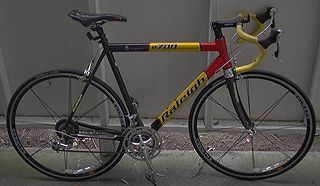
A racing bicycle, also known as a road bike, and once popularly known as a ten speed, is a bicycle designed for competitive road cycling, a sport governed by and according to the rules of the Union Cycliste Internationale (UCI). The UCI rules were altered in 1934 to exclude recumbent bicycles.
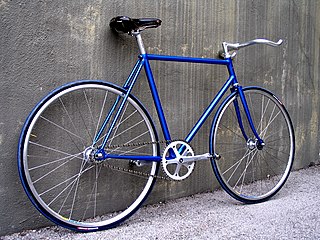
A fixed-gear bicycle is a bicycle that has a drivetrain with no freewheel mechanism. The freewheel was developed early in the history of bicycle design but the fixed-gear bicycle remained the standard track racing design. More recently the "fixie" has become a popular alternative among mainly urban cyclists, offering the advantage of simplicity compared with the standard multi-geared bicycle.

Flatland is a freestyle BMX riding style performed on smooth flat surfaces that do not include any ramps, jumps, or grindrails. It is sometimes described as a form of artistic cycling with a blend of breakdancing.
SRAM LLC is a privately owned bicycle component manufacturer based in Chicago, Illinois, United States, founded in 1987. SRAM is an acronym comprising the names of its founders, Scott, Ray, and Sam,. The company is known for producing cycling components, including some internally developed, such as Grip Shift, EAGLE (1x12), DoubleTap, dedicated 1x11 mountain and road drivetrains and SRAM Red eTap.

A handcycle is a type of human-powered land vehicle powered by the arms rather than the legs, as on a bicycle. Most handcycles are tricycle in form, with two coasting rear wheels and one steerable powered front wheel. Despite usually having three wheels, they are also known as handbikes.
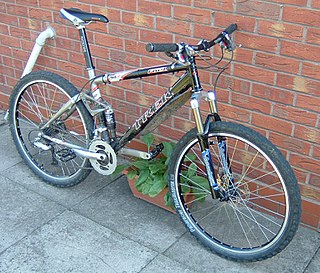
Bicycle suspension is the system, or systems, used to suspend the rider and bicycle in order to insulate them from the roughness of the terrain. Bicycle suspension is used primarily on mountain bikes, but is also common on hybrid bicycles.

A bicycle handlebar is the steering control for bicycles. It is the equivalent of a steering wheel for vehicles and vessels, but is most often directly mechanically linked to a pivoting front wheel via a stem which in turn attaches it to the fork. Besides steering, handlebars also often support a portion of the rider's weight, depending on their riding position, and provide a convenient mounting place for brake levers, shift levers, cyclocomputers, bells, etc.

Bicycle drivetrain systems are used to transmit power on bicycles, tricycles, quadracycles, unicycles, or other human-powered vehicles from the riders to the drive wheels. Most also include some type of a mechanism to convert speed and torque via gear ratios.

A quick release skewer is a mechanism for attaching a wheel to a bicycle. It consists of a rod threaded on one end and with a lever operated cam assembly on the other. The rod is inserted into the hollow axle of the wheel, a special nut is threaded on, and the lever is closed to tighten the cam and secure the wheel to the fork. Wheels equipped with quick release mechanisms can be removed from the bicycle frame and replaced without using tools by opening and closing the cam lever, thus more quickly than wheels with solid axles and nuts. On the negative side, a quick-release hub renders a wheel more vulnerable to theft and care must be taken to ensure that the mechanism is properly tightened.

Superpedestrian Inc., is a transportation robotics company based in Cambridge, Massachusetts, that develops micromobility technologies for small-scale electric vehicles. The company works with ride-hailing, scooter sharing, and bike sharing companies to improve the safety and reliability of their shared vehicle fleets. Superpedestrian is also the manufacturer of a consumer-facing product known as the Copenhagen Wheel, an electric bicycle wheel that transforms a traditional bicycle into a hybrid e-bike.
References
- 1 2 3 4 O’Conner, Brian. Slide Into More Control with Slidepad. Kinetic Shift. June 22, 2011.
- 1 2 3 Jurries, Amy. Endo Crashes A Thing Of The Past. The Gear Caster. March 17, 2011.
- ↑ New Company Launches Brake System. Bicycle Retailer and Industry News. February 25, 2011.
- 1 2 "Nordin joins Slidepad Technologies as advisor". Bicycle Retailer.
- 1 2 Slidepad Secures Taiwan Manufacturing. Bicycle Retailer and Industry News. June 10, 2011.
- 1 2 3 "Slidepad wraps up 'Save Your Teeth Tour'". Bicycle Retailer. November 30, 2012.
- ↑ Smith, Chip and Alex Strickland. Jamis Bicycles Latest Manufacturer to Feature Slidepad. SOAR Communications. November 9, 2011.
- ↑ Reid, Carlton. Single lever break system gets Asian production slot. Bike Biz. June 8, 2011.
- ↑ Overholt, Zach. One Lever, Two Breaks: Slidepad. Bike Rumor. May 16, 2011.